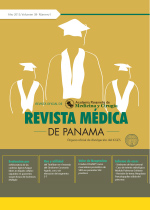Tasa de supervivencia y libre enfermedad en pacientes con cáncer cervicouterino. Instituto Oncológico
Autores/as
DOI:
https://doi.org/10.37980/im.journal.rmdp.2014162Resumen
Introducción: el cáncer cervicouterino constituye un problema de salud para los países en desarrollo, ocupando el segundo lugar en mortalidad dentro de los tumores femeninos, llevando a una sobrevida baja.
Objetivo: describir las tasas de supervivencia y libre enfermedad a los 5 años en las pacientes con cáncer cervicouterino atendidas en el Instituto Oncológico nacional, enero-julio 2006 al 2011.
Métodos: estudio descriptivo de cohorte retrospectiva. El universo fueron todas las pacientes atendidas con cáncer cervicouterino en el instituto desde enero a julio del 2006. Se recogió los datos de los expedientes mediante una encuesta previamente elaborada por los autores.
Resultados: de 123 pacientes atendidas durante el periodo de estudio solo se obtuvo 88 expedientes (71.5%). La edad promedio fue de 50.3 ± 14.2. El estadio clínico I (52.3%) fue el más frecuente seguido del II (23.9%). La estirpe histológica predominante fue el carcinoma de células escamosas (85.2%) seguido del adenocarcinoma (10.2%). Las tasas de supervivencia global y de libre enfermedad a los 5 años fueron de 74 y 70% en todos los estadios clínicos y tipo de tratamiento agrupados, y fue mayor para el estadio clínico I (85% y 80%) seguido del II (76% y 81%) respectivamente.
Conclusión: Las tasas de supervivencia global y de libre enfermedad fue bastante alta para los estadios clínicos tempranos destacando así la importancia de la detección temprana.
Free survival and disease in patients with cervical cancer studied from 2006 to 2011In the National Cancer Institute.
Abstract
Introduction: Cervical cancer constitutes a health issue for developing countries, ranked second in mortality in female tumors, leading to low survival.
Aim: Describe the disease-free and survival rates at 5 years in patients with cervical cancer treated at the National Oncologic Institute, from January to July 2006 to 2011.
Methods: This is a retrospective descriptive cohort study. The universe was all the patients treated for cervical cancer at the institute from January to July in 2006. The data were collected from records through a survey previously elaborated by the authors.
Results: From 123 patients treated during the period of the study only 88 records were obtained (71.5%). The average age was 50.3 ± 14.2. The clinical stage I (52.3%) was the most frequent, followed by stage II (23.9%). The predominant histological lineage was squamous cells carcinoma (85.2%) followed by adenocarcinoma (10.2%). The overall survival and disease-free rates were 74 and 70% in all clinical stages and treatments altogether, and was higher for the clinical stage I (85 and 80%) followed by stage II (76 and 81%) respectively.
Conclusions: The overall survival and disease-free rates were high for early clinical stages thereby highlighting the importance of early detection.
Key Word: cancer, cervical, survival, disease-free rate.
Publicado
Número
Sección
Licencia
Derechos autoriales y de reproducibilidad. La Revista Médica de Panama es un ente académico, sin fines de lucro, que forma parte de la Academia Panameña de Medicina y Cirugía. Sus publicaciones son de tipo acceso gratuito de su contenido para uso individual y académico, sin restricción. Los derechos autoriales de cada artículo son retenidos por sus autores. Al Publicar en la Revista, el autor otorga Licencia permanente, exclusiva, e irrevocable a la Sociedad para la edición del manuscrito, y otorga a la empresa editorial, Infomedic International Licencia de uso de distribución, indexación y comercial exclusiva, permanente e irrevocable de su contenido y para la generación de productos y servicios derivados del mismo. En caso que el autor obtenga la licencia CC BY, el artículo y sus derivados son de libre acceso y distribución.











